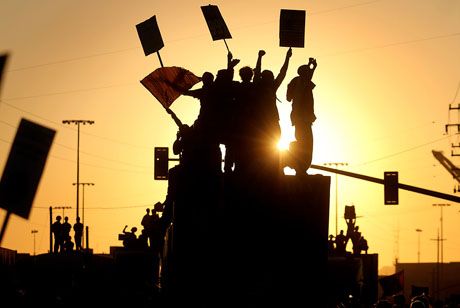Features
You are here
Chicago teachers and Quebec Students: winning strikes and union renewal

November 28, 2012
In the midst of mounting austerity attacks in North America, the Quebec students and Chicago teachers strike victories contradict the notion that workers and students are complacent and show that it is possible to use trade union structures to successfully fight the austerity agenda.
Quebec students won a “complete victory.” They won their demand to stop a tuition hike. In the process they also brought a government down and ended a draconian law intended to stop them.
Chicago teachers won a significant but not complete victory. They stopped a merit pay scheme and reduced the impact of teacher evaluations tied to student tests scores. Notably they achieved this facing a bipartisan assault on public education spearheaded by powerful Democratic mayor and former Obama Chief of Staff, Rahm Emmanuel.
Both strikes were successful and remarkable because of mass rank-and-file involvement. What was particularly notably was the identical method used by the Quebec students and the Chicago teachers to build and organize. In both cases it was a very specific process of face-to-face, member-by-member and member-to-community engagement that was the key to creating the groundswell of support by union members and got the support of the broader community.
This “back-to-basics” approach seems so obvious and is regularly touted as the antidote to top down, business unionism that is being criticized in all quarters. Yet in practice, criticizing the leadership instead of organizing members seems to be the default approach of most activists. What these strikes showed is that it is not what is directed at the leadership but what is directed at the membership that will shape the struggle and determine the outcome.
The ‘Practical Struggle’
Former CLASSE spokesperson Gabriel Nadeau-Dubois referred to the process of building the Quebec student strike as the “practical struggle.” In a recent talk he said, “thousands of student activists woke up early every morning for two years before the strike to distribute monstrous amounts of leaflets and newspapers.” He called this “culture of work” the key for building the mass democratic structures of the strike. Further he said that without the “culture of work,” general assemblies could have been called, but they would have been empty.
Similarly in Chicago, the Caucus of Rank and File Educators (CORE)—who first won the leadership of the Chicago Teachers Union (CTU) then won the strike—employed the sameface-to-face method. Beginning in 2010, CORE organized members, students, parents and the community to fight school closures and charter school “flips.” They repeated this method in the lead up to the strike, organizing action committees in every school tied to the teachers’ representative body, called the “House of Delegates.” The strike vote garnered a phenomenal 90 per cent turnout from teachers. The strike itself had massive popular support from both teachers and public on the picket lines and at mass rallies.
Political Strategy
In both cases the strikes were organized around clear and concrete issues and demands that allowed for the broadest layer of support.
The Quebec students organized around one simple demand, “stop the tuition hike”—a 75 per cent increase over three years. This concrete demand allowed for a broad layer of student support. It also kept the three participating student unions with different politics united despite intense pressure and attempts by the government to divide them.
For Chicago teachers the key was challenging the barrage of anti-teacher and anti-union rhetoric blaming teachers for poor student performance. Mayor Emmanuel used this rationale to attacks teachers and promote the bipartisan supported “education reform” agenda—code for a privatization and corporatization scheme. To counter the rhetoric the new leadership of the CTU commissioned the Schools Chicago Students Deserve report that clearly tied together teacher’s working conditions with students learning conditions . Moving toward the contract deadline, the new CTU leadership worked with contract action committees and local school delegates to raise the main points of the report and campaign for teacher support based on increasing the quality of public education not destroying. This strategy garnered a huge hearing for teachers’ demands and got broad support.
At critical points, mass rallies gave the strikes a profile on the street and tested the mood of the public. Historic demonstrations of hundreds of thousands in Quebec, particularly following the passing of draconian Bill 78, put huge pressure back on the Charest government. Thousands came onto the streets of Chicago at Grade-Ins and mass rallies creating huge blowback against Mayor Emmanuel exposing his bully tactics.
Structure and Leadership
Nadeau-Dubois credited the success, size and tenacity of the Quebec struggle to the structure of the strike and its relation to democratic decision-making. He referred to the strike structure as the mechanism for giving individual voices the “power of decision”—when people see the decisions articulated by the leadership reflecting their will.
Critically, Nadeau-Dubois identified the need for a centralized structure to make the power of decision effective on the mass scale of the Quebec strike. The coordination would not have been possible, he said, with an autonomous structure.
This democratic centralist model also requires that the leadership be extremely disciplined to carry the decisions of their members forward without second guessing or bowing to other pressures.
This was crucial at critical moments in both strikes. The question of the continuation of the Quebec strike over many months was firmly in the hands of the students through their assemblies. When a majority of students decided to stop the strike as a strategic retreat during the Quebec election campaign, the leadership complied.
In Chicago, union democracy and leadership discipline was preserved throughout the process of the strike even with huge pressure coming from Mayor Emmanuel. When the bargaining team got a tentative deal, Emmanuel threatened an injunction of picketing if teachers did not stop immediately. The leadership refused to end the strike until the House of Delegates—teachers’ local representatives—had a chance to review the deal and signal their approval.
Union Renewal and Broader Political Struggle
The ferocity of the austerity attacks and tepid response of the labour movement leadership has created frustration and exasperation among activists watching workers get hammered. The result has mostly been a see-saw between desperate appeals and harsh criticism of the leadership. But this is being addressed to a leadership entrenched in a consumerist union model and immune from the attacks faced by the workers they are supposed to represent. Their role now, and historically, has been to lower workers expectations in times of economic crisis or run to the front of rising struggles to dissipate them.
The recent CAW-CEP merger strategy indicates that pressure from members on the leadership is having some effect. The merger document and messages from the leaders about boosting rank-and-file activity and increasing resources for organizing sound great. Sadly, mere weeks after the merger was announced, the CAW leadership offered concessions without a fight—despite having 90 percentile strike votes in hand.
Constant criticism addressed to the leadership entrenches the notion that it must be the leadership that initiate action. The success of the Chicago teachers and Quebec students shows that rank-and-file members can lead this struggle. This approach has been successfully used this past year by both Toronto library workers and Alma steel workers.
Furthermore, the size of the Quebec and Chicago strikes propelled them past the initial demands to a broader political struggle. In both cases, this escalation pushed back significantly on the government attempts to keep the upper hand. In Quebec, it led to the collapse of the Charest government. In Chicago, Democratic support for “education reform” and the attack on teachers backfired when weeks before the last election, Republicans were praising Democratic mayor Emmanuel. Teachers’ demands were met in less than one week.
The back-to-basics approach takes time and tenacity. More fundamentally it requires an investment in the members and trust that they will act in their our interest supported by solid strategy and organization. It is not new but as these strikes show, it is effective.
Section:
- Log in to post comments










